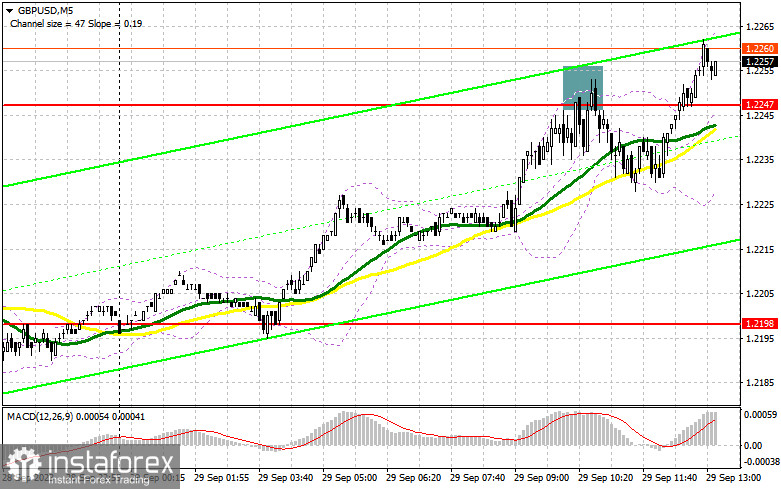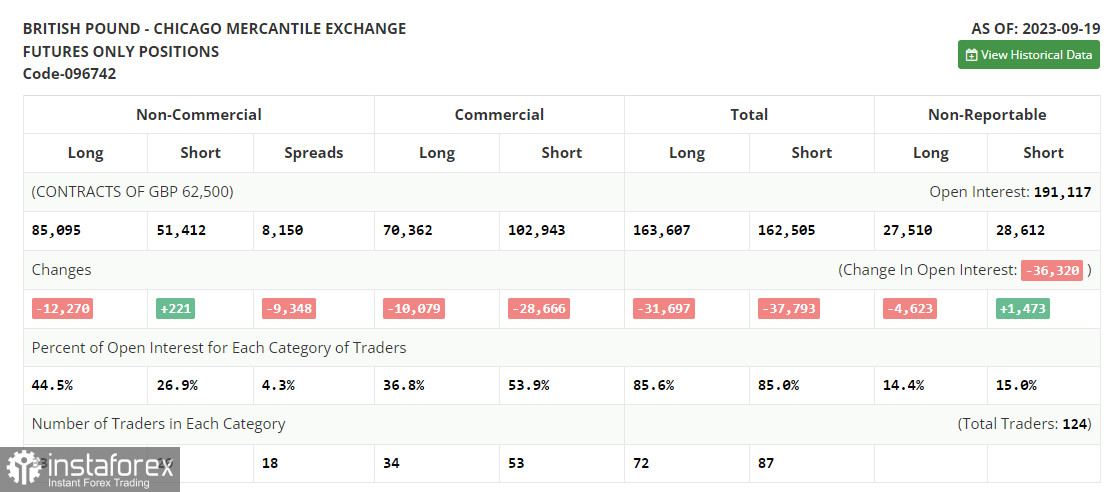In my morning forecast, I drew attention to the level of 1.2247 and recommended making trading decisions based on it. Let's take a look at the 5-minute chart and analyze what happened there. The rise and the formation of a false breakout around 1.2247 resulted in a selling signal, which led to a movement of almost 20 points, but more active selling did not materialize. The technical picture was slightly revised for the second half of the day.

To open long positions on GBP/USD, the following is required:
The released data on lending in the UK turned out to be not as bad as they could have been, which continued the bullish momentum in the pair that started early in the European session after strong GDP growth figures. During the American session, we expect data on the core Personal Consumption Expenditures Index in the US – an indicator preferred by the Federal Reserve to gauge inflation levels, as well as data on changes in US population spending and income. A decrease in all these indicators will be a bearish signal for the dollar, leading to a continuation of the pair's upward correction. If pressure on the pound returns, buyers will have to demonstrate their presence around 1.2233. A false breakout at this level will provide an entry point for long positions, counting on further corrections to around 1.2288. A breakout and consolidation above this range will boost buyers' confidence, signalling an opening of long positions targeting 1.2327, where I expect more significant sellers to appear. The ultimate target will be the area around 1.2375, where I will take a profit. In the scenario of a drop to 1.2233 and the absence of buyer activity in the second half of the day, the pressure on GBP/USD will return. In that case, only protection at 1.2198, where moving averages intersect, and a false breakout there, will signal opening long positions. I plan to buy GBP/USD immediately on a rebound only from the minimum of 1.2159, targeting a correction of 30-35 pips within the day.
To open short positions on GBP/USD, the following is required:
Apparently, the correction for the pound is gaining momentum, so be extremely cautious with selling in these conditions. Only the defense of the nearest resistance at 1.2288, along with statistics on US inflation growth, will allow achieving a false breakout at 1.2288 and an entry point for short positions. The target in this case will be the new support at 1.2233, formed after the first half of the day. A breakout and a reverse test from below to above this range will deal a serious blow to the bullish positions, providing an opportunity for a drop to the support at 1.2198. The more distant target remains the area around 1.2159, where I will take a profit. In the scenario of GBP/USD rising and the absence of activity at 1.2288 in the second half of the day, which seems likely, buyers will have an excellent opportunity for further building an upward correction. In this case, I will postpone selling until a false breakout at 1.2327. If there is no downward movement, I will sell the pound immediately on a rebound from 1.2375, but only counting on a pair's correction down by 30-35 points within the day.


Indicator Signals:
Moving Averages
Trading is conducted above the 30 and 50-day moving averages, indicating the formation of an upward correction for the pound.
Note: The period and prices of moving averages considered by the author are on the H1 hourly chart and differ from the general definition of classic daily moving averages on the D1 daily chart.
Bollinger Bands
In case of a decline, the lower boundary of the indicator at around 1.2170 will act as support.
Description of Indicators:
• Moving Average (determines the current trend by smoothing volatility and noise). Period 50. Marked in yellow on the chart.
• Moving Average (determines the current trend by smoothing volatility and noise). Period 30. Marked in green on the chart.
• MACD Indicator (Moving Average Convergence/Divergence) Fast EMA period 12. Slow EMA period 26. SMA period 9.
• Bollinger Bands. Period 20.
• Non-commercial traders - speculators such as individual traders, hedge funds, and large institutions using the futures market for speculative purposes and meeting specific requirements.
• Long non-commercial positions represent the total long open positions of non-commercial traders.
• Short non-commercial positions represent the total short open positions of non-commercial traders.
• The total non-commercial net position is the difference between the short and long positions of non-commercial traders.





















